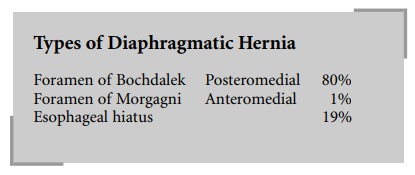Chapter: Clinical Cases in Anesthesia : Congenital Diaphragmatic Hernia
Describe the embryology and pathophysiology of congenital diaphragmatic hernia (CDH)
Describe the embryology and pathophysiology of congenital
diaphragmatic hernia (CDH).
The incidence of CDH is 1–2:5,000 live births.
There may be associated congenital anomalies of the central nervous,
gastrointestinal, genitourinary, and cardiovascular systems. In the fetus,
during the first month of life there is a single pleuroperitoneal cavity.
During the second month, the pleuroperitoneal membrane begins to form,
separating the pleural and peritoneal cavities. The last portion of this
membrane to form is the posterolateral portion, the right side closing before
the left side. The fetal gut is outside the pleuroperitoneal cavity in the yolk
sac during the first month of fetal life and returns to the peritoneal cavity
during the second month of development. If the gut returns prior to full
closure of the pleuroperitoneal membrane, any or all portions of the gut may
migrate up into the pleural cavity. There are three sites where migration of
the gut may occur:
· posterolateral (foramen of Bochdalek)
· anteromedial (foramen of Morgagni)
· esophageal hiatus
The most common site of migration (80%) is
through the posterolateral portion, the left side more commonly than the right.
Approximately 1% of diaphragmatic hernias occur through the anteromedial
portion and the remaining cases occur through the esophageal hiatus.
Lung development is impaired by the presence of
abdominal contents in the pleural cavity during fetal growth. The degree of
impairment of lung development is determined by both the amount of abdominal
contents in the pleural cavity and the time of migration. The greater the
amount of abdominal contents in the pleural cavity and the earlier the
migration, the greater the degree of pul-monary hypoplasia that will be present
at birth. Not only is the ipsilateral lung affected but there are developmental
changes in the contralateral lung as well. These changes include:
· decreased number of bronchi and alveoli
· smaller pulmonary artery
· inappropriately muscularized pulmonary arteries
· decreased cross-sectional area of pulmonary
artery branches
The physiologic changes that occur secondary to
the developmental changes in the lung are an increase in pul-monary vascular
resistance (PVR) and persistent pulmonary hypertension (PPHN). This is
reflected in the neonate as progressive hypoxia and acidosis. These physiologic
changes can be divided into two components:
·
Irreversible: due to pulmonary hypoplasia and abnormal vasculature.
·
Reversible: due to vasoconstriction of the abnormal muscularized arteries.
The greater the irreversible component, the
poorer the prognosis. To date, there is no method available to accurately
determine which component is predominant.
Although compression of the lung by the
presence of abdominal contents in the pleural cavity is detrimental, it does
not significantly contribute to the hypoxia and acido-sis that may be present.
Therefore, CDH is no longer con-sidered a surgical emergency. The initial
management of these neonates is directed at improving oxygenation and
ventilation. Only after stabilization of the neonate’s condi-tion should
surgery be entertained.


Related Topics